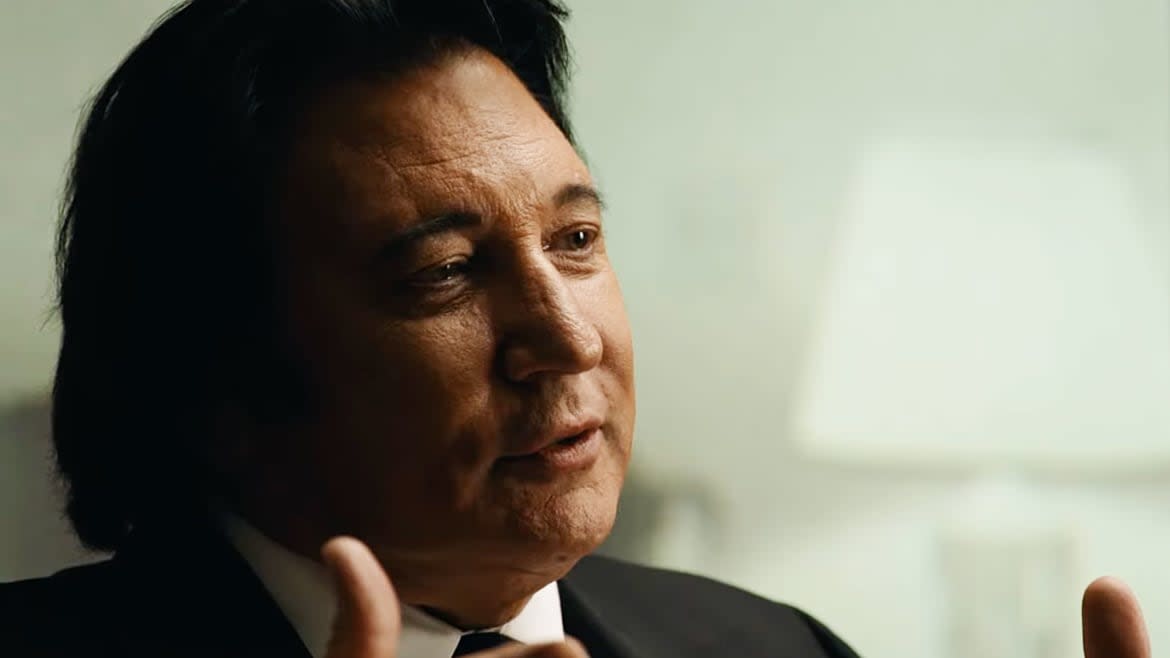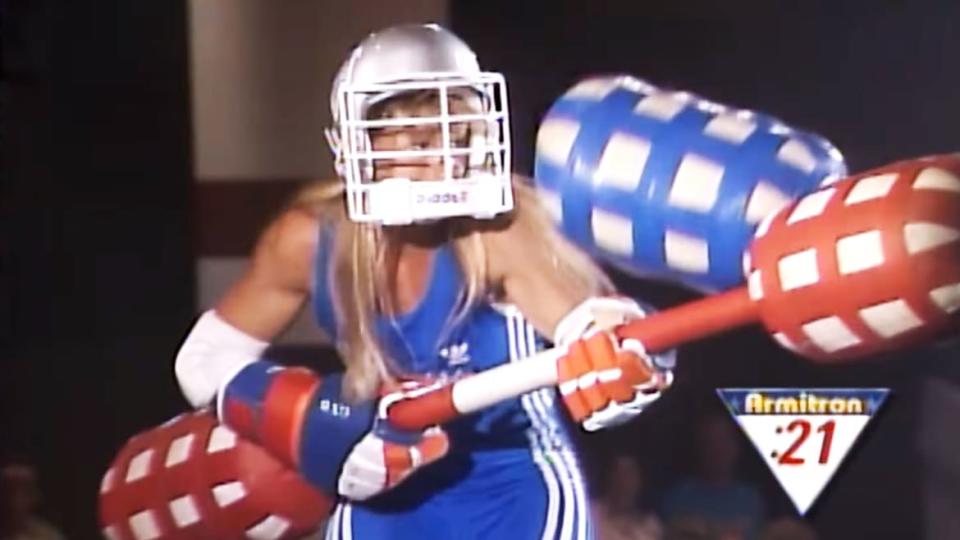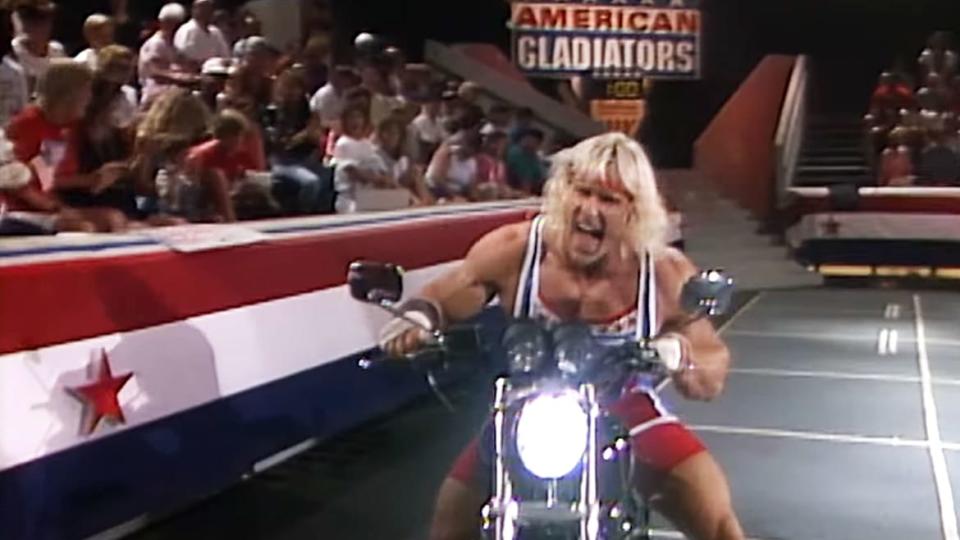The Ugly, Backstabbing Treachery Behind ‘American Gladiators’

Every pop culture phenomenon now gets an additional 15 minutes of fame courtesy of a nostalgic non-fiction documentary. So it was perhaps inevitable that someone would turn their attention to American Gladiators, the influential TV series that ran from 1989 to 1996 (and was briefly revived in 2008) and pitted contestants against titans in a variety of brutal David-versus-Goliath athletic challenges. Fortunately, that someone is director Benjamin Berman, who, as with 2019’s The Amazing Johnathan Documentary, transforms what might have been a conventional profile piece into a multilayered and moving treatise on success, exploitation, betrayal, brotherhood, and the catastrophic warfare that can come from chasing a beloved dream.

The latest installment of ESPN’s celebrated “30 for 30” series, the two-part American Gladiators Documentary (May 30) begins as a straightforward revisitation of the past, providing an outline of the show’s inception, rise to stratospheric heights, and cancellation, via interviews with a few of the larger-than-life men and women who starred as Gladiators. Gemini (Michael Horton), Malibu (Deron McBee), Elektra (Salina Bartunek), and Sabre (Lynn “Red” Williams) offer candid first-person accounts of their heady celebrity experiences, along the way touching upon the daddy issues, gangland anger, and party-hard wildness that colored their time doing battle for the viewing pleasure of millions. Their colorful anecdotes lend the material its humor and its sorrow, the latter born from personal tragedies, professional flameouts, and the myriad injuries that left them bruised and battered—and, in the case of Thunder (William Smith), permanently disabled and deeply regretful.
The main attraction in The American Gladiators Documentary, though, is Johnny Ferraro, the impresario who shepherded American Gladiators to the top. A former Elvis impersonator and native of Erie, Pennsylvania, Ferraro admits, “I was looking for something to be in the limelight.” and, “I wanted to build my own thing.” What he concocted was a movie about rugged blue-collar Americans who became superheroic do-gooders, and he took it to Hollywood, where for six years his pitch fell on deaf ears. However, after watching Oh, God! You Devil and pledging to sell his own soul to Satan for a shot at the big time, he met a receptive producer who loved his American Gladiators concept and wanted to make it a TV show. For Ferraro, it was the moment he’d been waiting for, and he seized it with relish.
Sitting before the cameras, Ferraro comes across as a visionary, a salesman, and a cagey manipulator who—as conveyed by snippets of his phone conversations with Berman—is determined to have the documentary follow his own script. That’s most crucially true when it comes to “Apache” Dan Carr, who was credited as the co-creator of American Gladiators and yet remains a total mystery to many of the show’s performers. Ferraro and journalist Pat Cuneo elucidate that Carr was a burly brawler, champion arm wrestler, and “king of the Ironworks” union in Erie. He also became Ferraro’s de facto nightclub bodyguard and close friend, and it was Carr who genuinely came up with the idea for American Gladiators, which was an outgrowth of his rough-and-tumble Ironworks picnic competitions and was first publicly staged at a local gym on March 27, 1982.
Arnold Schwarzenegger’s New TV Show Is an Embarrassing Stain on His Action-Hero Legacy
Ferraro’s refusal to discuss why Carr isn’t in The American Gladiators Documentary implies that an ugly secret is lurking beneath the surface. So too does a textual note explaining that Carr is absent because Ferraro has legal control of his friend’s appearances and has banned him from participating. With the same shrewdness that he demonstrates in his traditional recap passages (as when American Gladiators’ next-man-up treatment of its stars is visualized via footage of hot dogs sliding down a processing-plant chute), Berman intimates that Ferraro and Carr’s relationship is a microcosm of the American origin story, with a white man stealing and profiting off a Native American’s (intellectual) property. At the same time, though, he stops short of making his doc a polemic; as is ultimately revealed, the truth is complicated and constantly evolving in surprising ways.

Having hinted at Ferraro’s greed (which is the ostensible reason numerous former Gladiators chose not to take part in this endeavor) and backstabbing treachery, The American Gladiators Documentary spends its back half trying to get as close as it can to Carr. In doing so, it delivers unexpected twists and comical irony—including the fact that American Gladiators was birthed by a union and then used (in 1989 and again in 2008, with its failed reboot) as handy programming for networks contending with writers strikes. Throughout, Berman operates like an expert juggler, such that the miniseries is equal parts fond reminiscence, winding investigation, vibrant character study, historical survey, formal comedy (replete with British narration), and insightful, melancholic meditation on physical and psychological strength.
‘Bama Rush’ Goes Inside the Toxic, Faux-Feminist Hell of Sorority Life
Most of all, though, The American Gladiators Documentary is funny, whether Berman is drolly making himself (and the miniseries) a part of the story, cutting to vistas of the cosmos that cast his tale in mythic terms, filming dramatic recreations of Carr’s memoir Tuf Luck, or spotlighting some of American Gladiators’ unique personalities. Take, for instance, art director Steve Graziani, who confesses about the outlandish competitions he devised, “I don’t want this on camera that much, but those were my drinking days.” Berman captures not only the many facets and figures who contributed to the creation of the show—whose pop culture reach, during its heyday in the early ’90s, extended far and wide—but the madcap energy that made it a sensation.
Ferraro and Carr’s brainchild was the byproduct of an era marked by steroids, fitness mania, pro wrestling, scant TV safety regulation, and an uninhibited bigger-is-better ethos. Consequently, Ferraro’s belief in its continuing relevance resonates as more wishful thinking than realism, if a stark example of his determination. Then again, The American Gladiators Documentary’s closing notes of reconciliation and rejuvenation suggest that nothing—including a ludicrous creative idea that’s seemingly run its course—is ever truly down for the count, especially with another writers strike currently raging, and in a modern streaming universe where the new is so often predicated on the old.
Get the Daily Beast's biggest scoops and scandals delivered right to your inbox. Sign up now.
Stay informed and gain unlimited access to the Daily Beast's unmatched reporting. Subscribe now.

